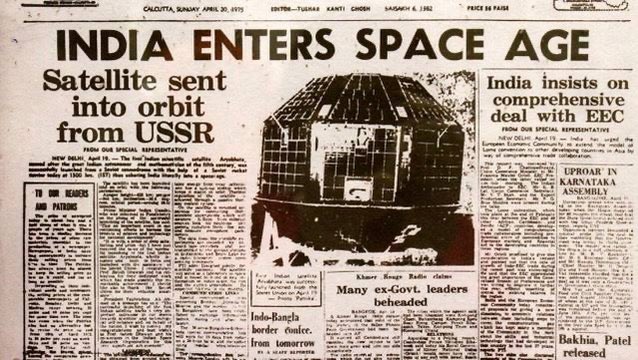On April 19, 1975, India made history by launching its first-ever satellite, Aryabhata. This was a big moment for the country, as it marked India’s entry into the space age. A newspaper called The Hindustan Times Weekly wrote about this exciting event on April 20, 1975, with a headline that shouted, “India Enters Space Age: Satellite Launched from Soviet Pad.” Let’s break down this amazing story in simple words so everyone can understand how India reached the stars, who made it happen, the challenges faced, and the final success.
What Happened on April 19, 1975?
India launched its first satellite, named Aryabhata, into space on April 19, 1975. This satellite was sent up from a place called Kapustin Yar, which is in the Soviet Union (a country that doesn’t exist anymore but was made up of many regions, including Russia). The Soviet Union helped India by providing a rocket called the Kosmos-3M to carry Aryabhata into space.
The newspaper headline said the satellite was making “sixteen rotations a day.” This means Aryabhata was circling the Earth 16 times every day, traveling at a very high speed in space. This was a proud moment for India because it became one of the few countries in the world to have a satellite in space.
What Was Aryabhata?
Aryabhata was a small satellite, shaped like a 26-sided polyhedron (a shape with many flat sides). It weighed about 360 kilograms, which is roughly the weight of a small car. The satellite was covered with solar panels to get energy from the Sun, and it had special tools inside to do scientific experiments.
Why Was It Called Aryabhata?
The satellite was named after a famous Indian astronomer and mathematician from the 6th century, also named Aryabhata. He was known for his amazing work in math and studying the stars, so naming the satellite after him was a way to honor India’s history of science.
Who Made This Happen?
The man behind India’s space dream was Dr. Vikram Sarabhai, often called the “Father of India’s Space Program.” He was a brilliant scientist who believed India could do great things in space, even though the country was still developing. Dr. Sarabhai started India’s space journey by setting up the Indian Space Research Organisation (ISRO) in 1969. He had a vision to use space technology to help India grow, like improving communication, weather forecasting, and education.
Dr. Sarabhai worked hard to make India a part of the space age. He talked to other countries, like the Soviet Union and the United States, to get their help. Sadly, Dr. Sarabhai passed away in 1971, before Aryabhata was launched. But his ideas and hard work made the launch possible. After his death, another scientist named UR Rao led ISRO and made sure Aryabhata reached space.
Help from the Soviet Union
India didn’t have its own rocket to launch the satellite back then, so it teamed up with the Soviet Union. In 1972, India and the Soviet Union made an agreement. The Soviet Union agreed to launch India’s satellite, and in return, India allowed the Soviet Union to use its ports for their ships. This teamwork was part of a program called the Soviet Interkosmos, which helped friendly countries like India get into space.
What Did Aryabhata Do in Space?
Aryabhata was called the “most modern experiment” by the newspaper because it was designed to do important scientific work. The satellite had three main jobs:
- Studying the Stars: Aryabhata carried tools to study X-rays coming from stars and other objects in space.
- Learning About the Sun: It also looked at the Sun to understand more about its energy and rays.
- Exploring Earth’s Atmosphere: The satellite studied the upper layers of Earth’s atmosphere to learn how space affects our planet.
These experiments were a big deal because they helped Indian scientists learn more about space and how it works.
Challenges India Faced
Launching a satellite in 1975 was not easy for India. The country faced many challenges along the way:
No Experience: India was new to space technology. Building a satellite and sending it to space was something the country had never done before.
Lack of Technology: Back then, India didn’t have its own rockets or launchpads. That’s why it needed help from the Soviet Union.
Money Problems: Space projects are very expensive, and India was not a rich country in the 1970s. Spending money on space was a big decision, but Dr. Sarabhai believed it was important for India’s future.
Learning Curve: Indian scientists had to learn a lot about how to build a satellite, how to make it work in space, and how to get the data back to Earth.
Despite these challenges, India’s scientists, inspired by Dr. Sarabhai’s vision, worked hard and never gave up.
The Final Success
On April 19, 1975, Aryabhata was successfully launched into space. The satellite reached an orbit around the Earth and started doing its experiments. The newspaper called it a “lucky day” for India because everything went according to plan.
Why Was This a Big Deal?
- Pride for India: Aryabhata showed the world that India could do big things in science and technology, even as a developing country.
- First Step in Space: This was the beginning of India’s space journey, a dream that started with Dr. Vikram Sarabhai. After Aryabhata, India went on to launch many more satellites and even sent missions to the Moon and Mars.
- Inspiration: The success of Aryabhata inspired young Indians to dream big and study science. It also showed that teamwork with other countries could help achieve great things.
Fun Fact About Aryabhata
Aryabhata was so important that its picture was printed on the back of India’s two-rupee note from 1976 to 1997. This was a way to celebrate India’s first step into space and make every Indian feel proud.
Honoring Vikram Sarabhai’s Legacy
Dr. Vikram Sarabhai’s work didn’t stop with Aryabhata. Many space centers in India are named after him, like the Vikram Sarabhai Space Centre (VSSC) in Thiruvananthapuram, Kerala, which builds rockets today. He also started the Physical Research Laboratory (PRL) in Ahmedabad in 1947, a place where scientists study space and physics. Even though he didn’t live to see Aryabhata’s launch, his dream of making India a space power came true.
What Happened After Aryabhata?
The success of Aryabhata was just the beginning. India kept working on its space program and built its own rockets, like the SLV (Satellite Launch Vehicle). In 1980, India launched another satellite called Rohini using its own rocket, becoming even more independent in space technology. Today, ISRO is known all over the world for its amazing work, like the Chandrayaan missions to the Moon and the Mangalyaan mission to Mars—all thanks to the foundation laid by Dr. Vikram Sarabhai.
To Conclude
Fifty years ago, on April 19, 1975, India took its first step into space with the launch of Aryabhata. This small satellite, built by ISRO and launched with the help of the Soviet Union, was a big achievement for India. It all started with the vision of Dr. Vikram Sarabhai, who dreamed of taking India to the stars. Despite many challenges, Indian scientists made it happen and showed the world that India could reach space. Aryabhata’s success inspired the country to keep exploring, and today, India is a leader in space technology. This moment in history reminds us that with hard work, teamwork, and big dreams, anything is possible!





